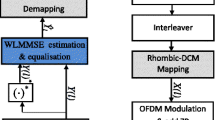Abstract
The time reversal (TR) technique combined with the ultra-wideband (UWB) system offers a new potential for decreasing the cost and complexity of the UWB receivers. In spite of TR–UWB's good performance in perfect channel state information (CSI), it is very sensitive to the channel estimation error. The effect of channel imperfection on the TR–UWB system is considered in this paper. At first, based on a minimum mean square error (MMSE) equalizer receiver, a prefilter is calculated in closed form to improve the performance of the TR–UWB system in an imperfect CSI scenario. Furthermore, for comparison purposes, a similar calculation for prefilter is carried out based on a simple matched filter (MF) receiver. Then, in order to improve the MF receiver performance, a two-stage iteration-based algorithm is developed. The initial value for this iteration-based improved algorithm is considered to be a prefilter which is calculated in the TR–UWB system with MMSE equalizer. This optimized algorithm causes the channel estimation error in the TR–UWB system to become zero in some steps. Finally, exhaustive simulations are done to demonstrate the performance advantage attained by the improved algorithm.








Similar content being viewed by others
References
Qiu RC (2006) A theory of time-reversed impulse multiple-input multiple-output (MIMO) for ultra-wideband (UWB) communications. IEEE International Conf. on UWB, Waltham, MA, pp. 587–592
Akogun A, Qiu RC, Guo N (2005) Demonstrating time-reversal in ultra-wideband communications using time domain measurements. The Instrumentation, Systems and Automation (ISA) 51st International Instrumentation Symposium, Knoxville, Tennessee, pp.1–5
Akogun AE (2005) Theory and application time reversal technique to ultra-wideband wireless communication. MSc thesis, Tennessee Technological University
Qiu RC, Zhou C, Guo N, Zhang JQ (2006) Time reversal with MISO for ultra-wideband communications: experimental results. IEEE Antenn Wirel Pr 5(1):269–273
Guo N, Sadler BM, Qiu RC (2007) Reduced-complexity UWB time-reversal techniques and experimental results. IEEE T Wirel Commun 6(12):4221–4226
Guo N, Zhang JQ, Qiu RC, Mo SS (2007) UWB MISO time reversal with energy detector receiver over ISI Channels, IEEE Consumer Commun. and Networking Conf., Las Vegas, Nevada, pp. 629–633.
Reed JH (2005) An introduction to ultra wideband communication systems. Prentice Hall PTR, New Jersey
Sheng H, You R, Haimovich AM (2004) Performance analysis of ultra-wideband rake receivers with channel delay estimation errors. Proc. Conf. Information Sciences and Systems (CISS’04), pp. 921–926
Guo N, Qiu RC, Sadler BM (2005) An ultra-wideband autocorrelation demodulation scheme with low-complexity time reversal enhancement, vol. 5. IEEE Milcom’05, Atlantic City, pp 3066–3072
Popovski K, Wysocki BJ, Wysock TA (2007) Modelling and comparative performance analysis of a time-reversed UWB system. EURASIP J Wirel Commun Netw 7:1–11
Liu X et al (2010) Post-time-reversal MIMO ultrawide band transmission scheme. IEEE T Antenn Propag 58(5):1731–1738
Strohmer T, Emami M, Hansen J, Papanicolaou G, Paulraj AJ (2004) Application of time reversal with MMSE equalizer to UWB Communications. Proc. IEEE Global Telecommunications Conference, Dallas, Texas, pp. 3123–3127
Wang T, Lv T (2011) Canceling interferences for high data rate time reversal MIMO UWB system: a precoding approach. EURASIP J Wirel Commun Netw 2011:1–10
Bizaki HK, Falahati A (2008) Tomlinson-Harashima precoding with imperfect channel state information. IET Commun 2(1):151–158
Lewis TO, Odell PL (1971) Estimation in linear models. Prentice Hall, Upper Saddle River
Petersen KB, Pedersen MS (2006) The matrix cookbook, p 17
Manning CD, Raghavan P, Schütze H (2009) An introduction to information retrieval. Cambridge University Press, Cambridge, Chapter 18
Haykin S (1996) Adaptive filter theory, 3rd edn. Prentice-Hall, Englewood Cliffs
Nguyen H, Zheng F, Kaiser T (2009) Antenna selection for time reversal MIMO UWB systems, IEEE 69th Vehicular Technology Conf., Barcelona, Spain, pp 26–29
Foerster JR (2003) Channel modeling sub-committee report final, Tech. Rep., IEEE 802.15 Working Group for WPAN
Molisch A, Cassioli D, Chong C et al (2006) A comprehensive standardized model for ultra wideband propagation channels. IEEE T Antenn Propag 54(11):3151–3166
Molisch AF, Foerster JR, Pendergrass M (2003) Channel models for ultra wideband personal area networks. IEEE Wirel Commun 10(6):14–21
Acknowledgments
The authors would like to thank the reviewers for their valuable comments to improve the quality of the work and Mr. Taotao Wang, PhD candidate in the Department of Information Engineering of the Chinese University of Hong Kong, for valuable guidelines on the simulation results.
Author information
Authors and Affiliations
Corresponding author
Rights and permissions
About this article
Cite this article
Khaleghi Bizaki, H., Alizadeh, S. Mitigation of channel estimation error in TR–UWB system based on a novel MMSE equalizer. Ann. Telecommun. 68, 317–325 (2013). https://doi.org/10.1007/s12243-012-0325-8
Received:
Accepted:
Published:
Issue Date:
DOI: https://doi.org/10.1007/s12243-012-0325-8




